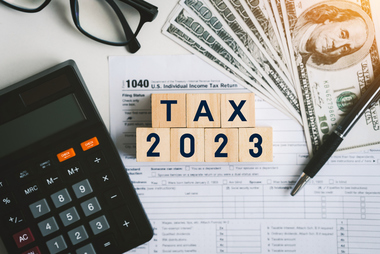Congress has not enacted significant tax legislation in 2023, although tax changes could be added to year-end budget legislation. In the meantime, tried and true tax planning techniques, the continuing tax ramifications of legislation enacted in 2022, and the scheduled 2026 expiration of many tax breaks leave taxpayers with many tax planning considerations.
Traditional year-end techniques include:
- Reviewing investment portfolios for potential losses than may offset gains taken elsewhere (taking wash sale rules into account).
- Maximizing contributions to 401(k) and IRA plans, considering Roth options where available.
- Making Required Minimum Distributions from retirement plans to avoid penalties. RMDs generally apply to beneficiaries 73 or older, but special rules apply to inherited IRAs.
- In a low-income year, or if net operating loss or other tax carryforwards are available, consider converting traditional IRA accounts into Roth IRAs.
- Taxpayers with estate tax exposure may gift tax-free up to $17,000 to any person in 2023 ($34,000 for married donors with gift-splitting), including to 529 college saving programs.
Many tax breaks for individuals that became effective in 2018 under the Tax Cuts and Jobs Act (TCJA) are scheduled to sunset after 2025. Taxpayers should keep this eventuality on their horizon – if Congress does not extend these tax breaks, realizing income before 2026 may result in lower income tax rates. TCJA also doubled the lifetime estate and gift tax exemption, so that it now shelters $12.92 million of assets per person. Barring Congressional action, this exemption is also scheduled to revert to pre-TCJA levels after 2025. Wealthy taxpayers may want to consider making sizable gifts before 2026, because gifts made under the current increased lifetime exemption will remain exempt from estate tax even after the exemption drops (there will be no “clawback”).

Although some COVID-inspired charitable deductions have expired, many charity related tax techniques and benefits remain:
- The 60% adjusted gross income limit on itemized charitable deductions is still in effect for 2023.
- So is the ability of individuals 70½ or older to make qualified charitable distributions of up to $100,000 annually directly from their IRAs. A new tax provision permits up to $50,000 of that sum to be distributed to a split-interest entity such as a charitable remainder trust.
- With the increased standard deduction, bunching of charitable contributions every other year may help exceed the standard deduction and claim itemized deductions. The use of donor-advised funds can assist with the bunching strategy.
- Donating appreciated stock remains a strategy to avoid capital gain tax on asset appreciation.
The $10,000 limit on state and local tax deductions has not changed, but most states have enacted a workaround available if state income taxes are paid through a partnership or S Corporation, or even a self-employed business. Steps to maximize this benefit generally must be taken by December 31. Since each state has different rules, check with your LMC advisor for the action needed in your case.
One year ago, President Biden signed the Inflation Reduction Act into law. Many of the clean energy and climate action provisions it added or extended may be used now to reduce 2023 taxes if eligible purchases are made by December 31. These green tax breaks include:
- The expansion of the Energy Efficient Home Improvement Credit from a lifetime $500 credit to a $1,200 annual credit. Many homeowners used up the old version of this credit many years ago but now have the more generous credit available for exterior improvements and installation of energy-efficient systems.
- The Residential Clean Energy Credit (for items like home solar heating, solar electrical, and wind installation), was restored to a 30-percent credit for 2023.
- The extended Clean Vehicle Credit retains its $7,500 maximum credit but is now divided into two $3,750 parts based on the sourcing of minerals and components. Those requirements, along with new rules regarding assembly in North American, may make this credit more difficult to obtain and keep some electric vehicles from qualifying. There are also new limits on the vehicle’s price and the buyer’s income.
- A new “Previously-owned Clean Vehicle Credit” offers a lower credit amount but has fewer requirements and different income limits.
Taxpayers with outside income may receive more tax information forms for 2023 than in prior years because a new rule requires third-party payment processors to issue Form 1099-K for transactions as low as $600 (the previous threshold was $20,000). You may also receive more than one 1099 for the same transaction—both a Form 1099-K from a third-party payment processor and either a Form 1099-MISC or a Form 1099-NEC from the payor.
The IRS focus on taxation of digital asset transactions keeps expanding. A question asking whether the filer has engaged in crypto currency transactions remains on page 1 of Form 1040, and the IRS has expanded its ability to obtain information about these transactions from brokers. The US continues to treat digital assets as property subject to capital gain and loss.
With two months left before 2023 ends, these are some of the ideas that can help cut your federal tax bill. Please reach out to your LMC professional for more information or any questions you may have.
 |
Written by Jeffrey S. Gold, CPA |



